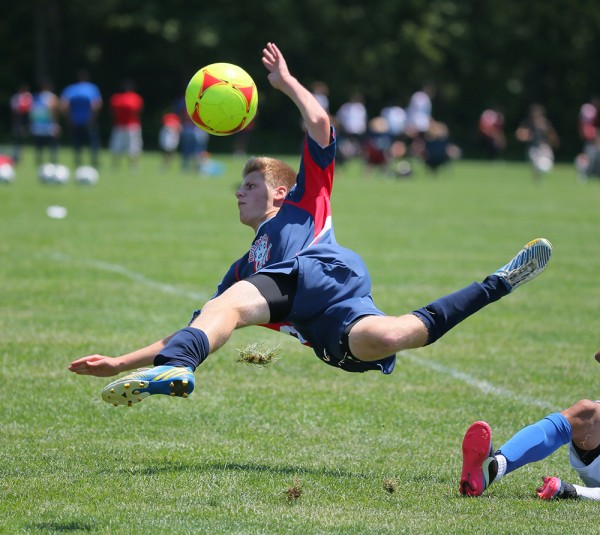
I moved out to the sideline for this shot. Right around the 18 yard line is a great place to stand and turn back to the goal for the action there. Canon EOS-1D X, EF 200-400 f/4L IS Extender 1.4X. 1/1000, f/5.6, ISO 800.
I spent a good portion of my career photographing sports, from children all the way up through the pros. One of the most challenging sports to photograph was soccer (football or futbol if you’re outside North America). I’ve had colleagues liken it to “photographing a moving tree in a moving forest” because you’re focused on one player, while other players are moving across the frame between you and the subject all the time. It takes patience and some knowledge of the game to be really good at photographing it.

This shot was part of a sequence that started with this player making a run with the ball. A few frames prior to this, he was tripped and went airborne along with the ball. I never would have had this frame if I wasn’t shooting at 12 fps. Canon EOS-1D X, EF 200-400 f/4L IS Extender 1.4x. 1/1600, f/5.6, ISO 800.

From behind the end line, you can often capture two players fighting for position on the ball. Canon EOS-1D X, EF 200-400 f/4L IS Extender 1.4x. 1/1000, f/5.6, ISO 400.
Soccer is a fast-moving sport and thus requires your camera to be set a certain way. I shoot most of my action using Aperture Priority, with the aperture set around f/4 or f/5.6. I want a pretty shallow depth of field so the athletes pop off the background, and so that background objects don’t distract from the subjects. I then set the ISO to be sure I get a fast enough shutter speed to freeze the action. Generally this means 1/500 minimum. Faster if you’re using a lens longer the 500mm. I set my camera’s autofocus system to AI Servo or Continuous (dependent on the brand of camera you use- it means the same thing). AI Servo or continuous simply means that your camera will focus on the subject and continue to track the subject as it moves towards or away from the camera. Finally, I set my camera’s drive to continuous so that I simply have to press and hold the shutter button to take multiple images. This enables me to take an entire sequence of action, meaning I won’t miss peak action by taking only one shot, or more importantly, I’ll get multiple images to choose from of the play to be sure I get the best shot out of the action. Note that some cameras have multiple continuous settings, such as continuous low or continuous hi. I suggest getting as many shots as possible and using continuous hi, if you have a choice. For instance, the images accompanying this article were taken using an EOS-1D X, with the drive set to Continuous Hi, which is 12 frames per second. Realistically, faster is better, but even a consumer camera firing at 4 frames per second can produce outstanding results.
Unfortunately, soccer is a sport that screams for long glass on your camera. The fields are so large, and the game so spread out, that putting anything less than a 300mm lens on the camera will leave you missing a lot of shots. Truth be told, a 500mm lens is ideal. I found a lens such as Canon’s EF 200-400 f/4L IS Extender 1.4x to be a great combination as I could zoom in and out and cover things close to me at 200mm, and zoom all the way in when the action moved away. Nikon makes a similar lens, without the 1.4x extender built in. For more cost-conscious options, lenses such as Canon’s 100-400mm or the many 70-300mm lenses on the market are also good choices.
When on the field, or pitch as the rest of the world calls it, I have several places I like to stand. My favorite place is behind the end line, to the side of the goal. This allows me an angle on the goalie when he comes out to make a play, but also gets action coming more or less right at me. I find it much easier to photograph players running towards me, rather than to try and pan with action moving parallel to me. When the action is coming to me, I don’t have to work to keep the AF point on the athletes. When I have to pan with the athletes, there’s always the chance I move too fast or too slow and the AF point loses focus.
I find the combination of speed and physicality to make soccer incredibly rewarding. I love capturing the players fighting for the ball, fighting for position. I love capturing the emotion as they score a goal, or the dejection of losing a big game. Spending an afternoon at a soccer game provides a ton of great opportunities, so go take advantage of them!

Occasionally, I’ll try something a little different. I had a lot of standard action from this game, so I decided to switch it up a bit and try some panning. The darker backgrounds lent themselves perfectly to this. Canon EOS-1D X, EF 200-400 f/4L IS Extender 1.4x. 1/10, f/36, ISO 100.
Post originally from: Digital Photography Tips.
Check out our more Photography Tips at Photography Tips for Beginners, Portrait Photography Tips and Wedding Photography Tips.
Get A Kick: Photograph Soccer!
You must be logged in to post a comment.